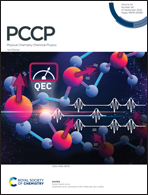Light-driven reduction of CO2: thermodynamics and kinetics of hydride transfer reactions in benzimidazoline derivatives†
Abstract
CO2 capture, conversion and storage belong to the holy grail of environmental science. We therefore explore an important photochemical hydride transfer reaction of benzimidazoline derivatives with CO2 in a polar solvent (dimethylsulfoxide) by quantum-chemical methods. While the excited electronic state undergoing hydride transfer to formate (HCOO−) shows a higher reaction path barrier compared to the ground state, a charge-transfer can occur in the near-UV region with nearly barrierless access to the products involving a conical intersection between both electronic states. Such radiationless decay through the hydride transfer reaction and formation of HCCO−via excited electronic states in suitable organic compounds opens the way for future photochemical CO2 reduction. We provide a detailed analysis for the chemical CO2 reduction to the formate anion for 15 different benzimidazoline derivatives in terms of thermodynamic hydricities (ΔGH−), activation free energies (ΔG‡HT), and reaction free energies (ΔGrxn) for the chosen solvent dimethylsulfoxide at the level of density functional theory. The calculated hydricities are in the range from 35.0 to 42.0 kcal mol−1i.e. the species possess strong hydride donor abilities required for the CO2 reduction to formate, characterized by relatively low activation free energies between 18.5 and 22.2 kcal mol−1. The regeneration of the benzimidazoline can be achieved electrochemically.



 Please wait while we load your content...
Please wait while we load your content...